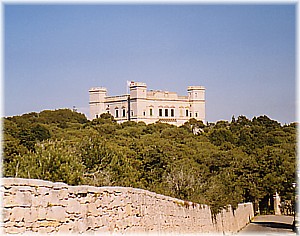verdala palace

verdala palace and buskett garden
The Verdala Palace
was the second important palace which was designed by Gerolamo Cassar. It is situated near Rabat at a
boschetto, the
Buskett Garden, in the centre of the island. The Palace was named after the
French Grandmaster Hughes de Loubenx Verdalle, and it used to serve as the
summer residence of every Grandmaster. Nowadays it is the summer residence of the
Maltese President.
 |
The Palace was
erected on a small hill in 1586, and Cassar had planned it as a fortified villa.
Grandmaster Verdalle wanted a residence that was strong enough to bear
attacks and that at the same time represented a comfortable and
representive villa.
The palace is nearly square in plan. The bastions on each corner merely have a symbolic task. The plan of the building was probably inspired by several other Italian buildings of this type which Cassar must have studied on his trip to Italy. |
| plan of verdala palace |
The building consists of two storeys, while the corner bastions have a third storey. The palace is surrounded by a garden. A small bridge, which runs over a ditch, leads to the main entrance. The entrance opens into a square entrance lobby. The room after the entrance lobby is rectangular and has a tunnel-vault. It probably served as the dining hall. Left and right of this hall one can find two square rooms. |
|
|
tunnel-vaulted hall on ground floor |
 |
The main facade lies in the north. On each side of the central portal two windows can be found. The door and the windows are surrounded by a simple frame. The second storey with the balcony, the balustrades, the windows with triangular pediments and the balustrade on top of the building are typical baroque and were all added later. Therefore, the building was orginally one-storeyed and must have looked very plain. |
 |
| main facade of verdala palace |
back side of verdala palace |
|
 |
The main staircase of Verdala Palace is an elliptic spiral staircase and was also designed by Gerolamo Cassar.
|
 |